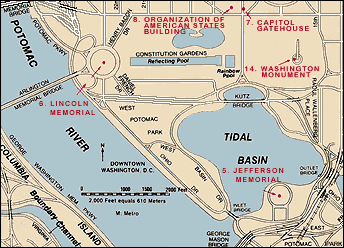



The Jefferson Memorial is made of marble and was dedicated in 1943.
The Jefferson Memorial is a marble building, dedicated in 1943. One of the most striking deterioration features to observe here is the loss of silicate mineral inclusions in the marble columns because of dissolution of the calcite matrix. Close examination of the grooves shows flakes of mica and sometimes grains of pyrite. Blackened crusts are visible on the column capitals that are sheltered from rain and from regular washing of the monument.
 |
 |
| Several of the column shafts at the Jefferson Memorial have grooves that follow the inclusion traces in the marble, where the mineral inclusions have weathered out and been lost. | A close look at some of the weathered grooves in the columns shows that small bits of mica and pyrite remain. |

|
|
| Part of one of the column capitals at the Jefferson Memorial broke off and fell onto the portico in 1990. | |
The National Park Service began a survey of the condition of this memorial and the Lincoln Memorial in 1992. The results will be used to help make decisions on treatment, cleaning, and preservation. The information gathered from the survey will serve as a known baseline for the condition of the stone, so that future changes in the condition of the buildings can be assessed. In May 1990, a part of one of the column capitals (called a volute) broke off and fell onto the northwest portico. This failure raised concern about all the volutes at the Memorial, so several other cracked volutes were removed, and studies are being conducted to determine why they cracked. Because of where and how the volute broke, it is unlikely that acid rain or air pollution contributed to the failure. The broken pieces will probably be replaced, but only when the reason for their failure is understood, so that an appropriate replacement technique can be chosen.

Sites 5-8
Map of All Sites on the Tour
[102 K image]